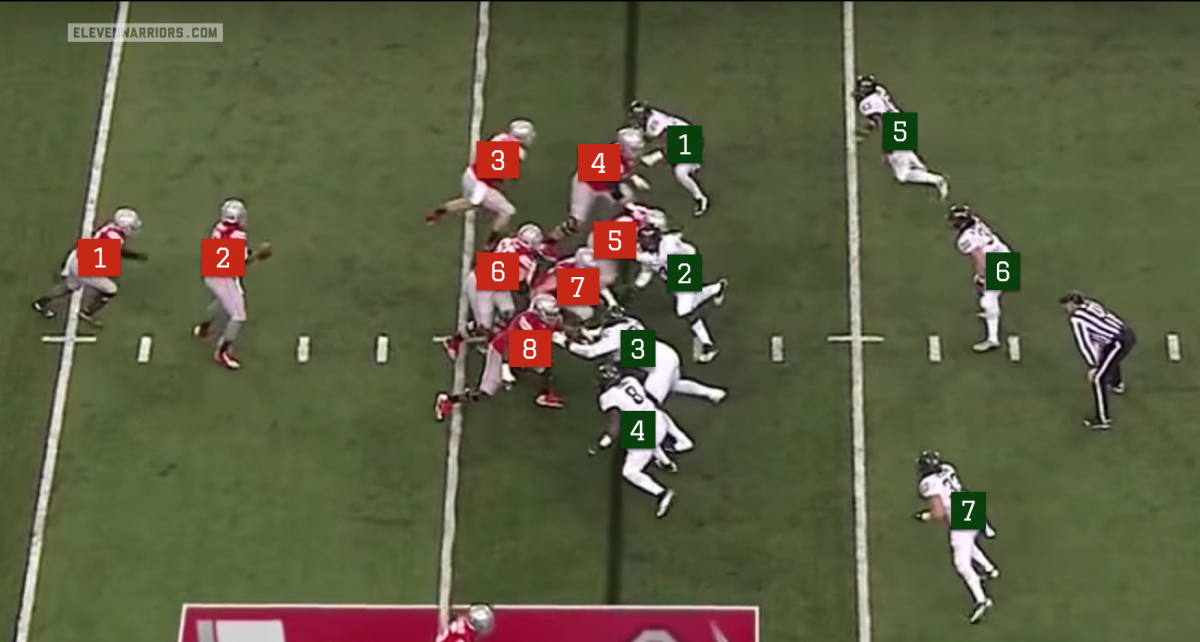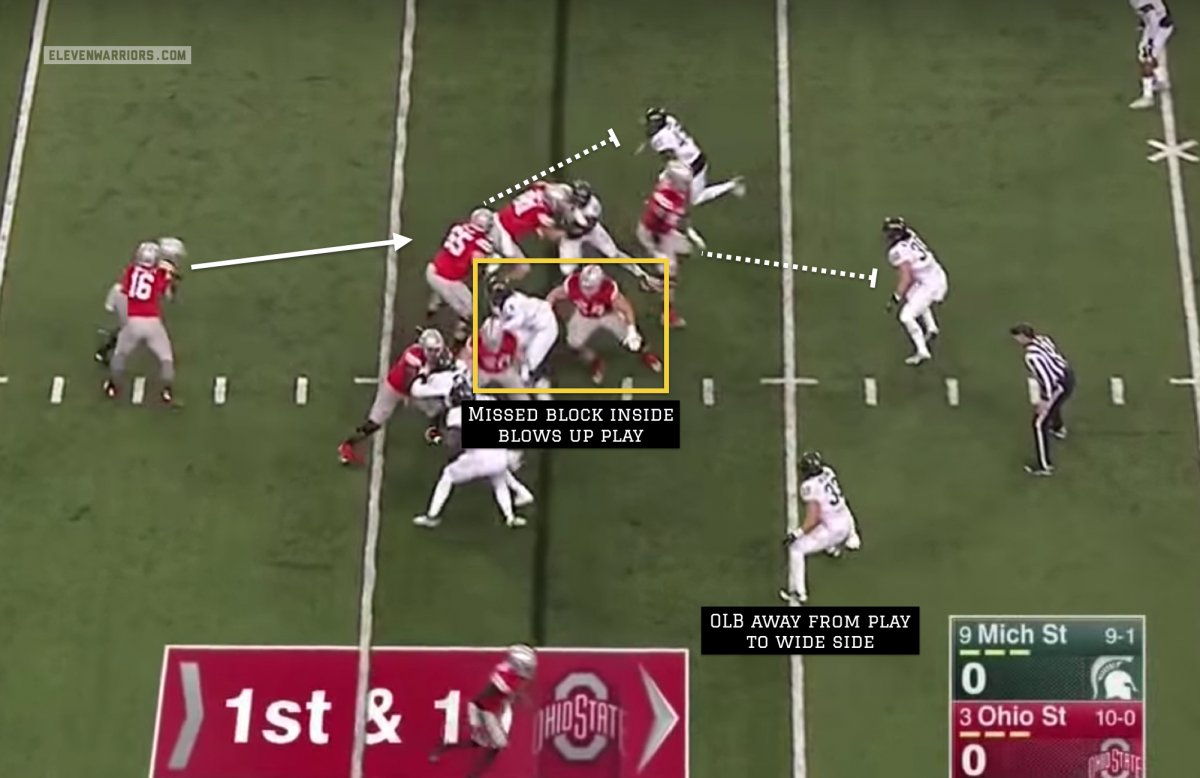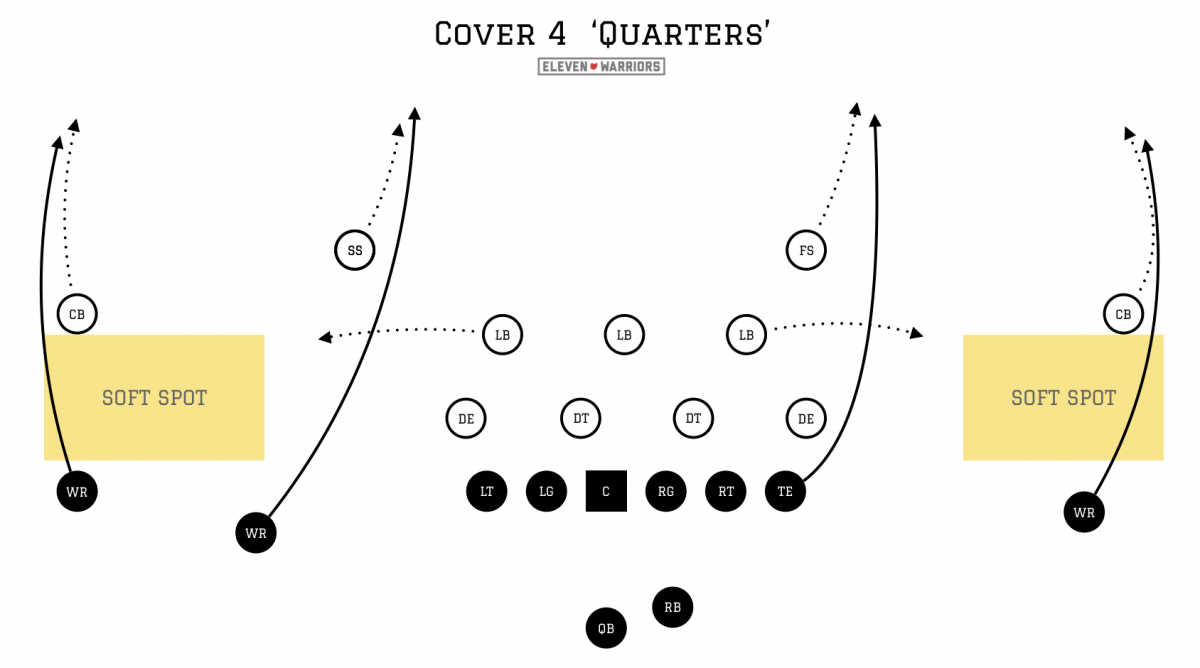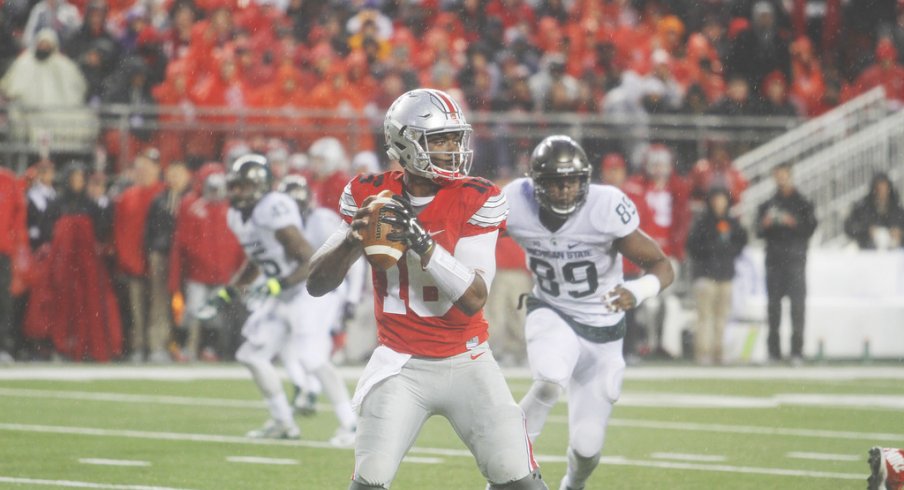After an impressive win in East Lansing the year prior, a game in which the Ohio State offense appeared to finally get past their stiffest annual competition, the 2015 contest between the two sides saw a very different result.
One week ago, we examined how the Buckeye passing game gashed their opponent in that 2014 matchup, taking the legs out of an opposing game plan that had been a constant thorn in the side of Urban Meyer during his tenure at OSU. With a deep threat in the form of Devin Smith to take the top off the Michigan State secondary, Meyer's running game thrived as his offense put up 49 points on one of the nation's most vaunted defenses.
In the previous match-ups between Meyer and his counterpart at MSU, Mark Dantonio, the latter had looked to slow down the former's potent ground game by bringing his safeties aggressively toward the line of scrimmage at even the slightest hint of a run, giving the defense as many as eight or nine defenders in the box. By throwing deep and challenging those safeties, the Buckeyes were able to stretch their opponents vertically, leaving the defensive front helpless against the pounding attack of J.T. Barrett, Ezekiel Elliott, and the Scarlet and Gray offensive line.
Although Barrett, Elliott, and four starters up front returned for the 2015 contest between these two sides, the Spartans took a slightly different tact. Though their opponents once again featured one of the nation's top rushing offenses, the Michigan State safeties played far more conservatively this time around, determined not to get beat deep once again.
Coming in undefeated and looking like a serious threat to defend their title in the College Football Playoff, this game plan should have been more than welcomed by the Buckeyes and their fans. As we now know however, things didn't seem to go according to plan.
Part of the reason Dantonio must have felt confident in his approach was due in large part to the abilities of his front seven defenders. Although the Buckeyes featured a first-round draft pick in tackle Taylor Decker and an all-conference guard in Pat Elflein, they struggled throughout the entire afternoon to consistently handle the Spartan front.
Early on, the Buckeyes looked to handle the harsh elements provided by Mother Nature by playing fairly conservatively, looking to establish Elliott and the running game. With both Spartan safeties playing back, the offense had eight players in the box compared to only seven defenders, a scenario Meyer and his team will always try to exploit.

Additionally, the Buckeyes would align their formation with two receivers to the wide side of the field, forcing the MSU SAM (Strong) outside linebacker to line up in that direction. Meanwhile, the offense would leave the tight end to the short (boundary) side and pull a guard as they ran Power, which should have given them an even more defined advantage in that direction.

From a game-planning perspective, this play should have led to Elliott picking up a few yards before even making contact with a defender, just as he had so many times over the past two seasons. But things didn't work out that way.

Lined up in the 'A' gap between the left guard Billy Price and center Jacoby Boren, MSU defensive tackle Malik McDowell uses a 'rip' technique to get underneath Price before Elliott has even received the handoff. This wasn't a scheme put in place by Dantonio's staff in the weeks leading up, it was simply one player beating his opponent in a one-on-one battle, and the result was a stuffed play on first down.
Such failures in execution up front were far too common that day, and not just in the running game. Although he'd only throw the ball 16 times (thanks in large part to the elements), Barrett often faced pressure thanks to breakdowns up front.
In the example below, the Spartans run the same Double-A-gap blitz they've run hundreds of times over the past few years, and should have never caught OSU by surprise. The defensive tackle (#92) goes outside Elflein at right guard with the two inside linebackers crossing paths before blitzing on either side of Boren (#50).

While it's hard to say which of the two offensive linemen was at fault, the point is moot as the end result was Barrett taking a big hit from an unblocked, blitzing linebacker. Even though he was able to get the ball off, the pass sailed away from the intended receiver for an incomplete pass.
This is not to say the offense was entirely a mess all day. When all eleven players filled their assignments properly, the Buckeyes were able to move the ball, as they did on a big third down in the fourth quarter.

The offense would align two receivers, a tight end, and Elliott at running back all to the boundary, daring the defense to overload their numbers in the same way. Keeping with their rather conservative alignment all day long, the Spartans were cut wide open thanks to some strong blocking by every Buckeye to that side of the field.
Since they lacked the same deep threat they'd possessed the year before in Smith, the OSU offense looked instead to stretch Dantonio's defense horizontally, using the Spartans' tendencies against them. In their Quarters scheme, the cornerbacks are put on islands to the outside, responsible for any deep pattern along the sidelines with the outside linebackers effectively responsible for any short action to the flats on either side.

If those same linebackers are tasked with stopping the run first, they can't get outside and help cover those soft spots, leaving that responsibility to the safeties behind them. But those safeties' top priority was not to get beat deep, meaning they played way off short, out-breaking routes from the inside receivers and giving the Buckeyes easy yards when they wanted them.

But catching a 5-yard out on 3rd-and-9 doesn't really help an offense. All too often, the Buckeyes found themselves in these 3rd-and-long situations against the Spartans, never putting together a solid drive all afternoon (both touchdowns came off fumble recoveries deep in MSU territory).
Perhaps more than any other, converting third downs on offense may be the biggest determining factor of success for Meyer's Buckeyes when the Michigan state defense:
| Year | Attempts | Conversions | Conversion rate | Game Result |
|---|---|---|---|---|
| 2012 | 13 | 6 | 46.15% | W 17-16 |
| 2013 | 10 | 1 | 10.00% | L 24-34 |
| 2014 | 14 | 10 | 71.43% | W 49-37 |
| 2015 | 14 | 4 | 28.57% | L 14-17 |
In both losses to the Spartans, the story was not simply that the Buckeyes didn't perform on 3rd down, but rather sloppy execution on the 1st or 2nd downs preceding them. Converting on 3rd-and-long has never been the strong suit of Meyer's offenses at OSU or elsewhere, meaning they can't afford to suffer negative or stuffed plays that go for no gain and force the unit to fall 'behind schedule.'
During the 2015 loss, these ineffective plays were far too common. While the weather was certainly blamed for these efforts after the fact, many (including Elliott) blamed the play-calling for these failures. With most of the same players that had won so handily the year prior, the change in play-calling duties from Tom Herman to Ed Warinner and Tim Beck seemed like an easy scapegoat.
Our brains want to believe that the recipe for success on the field is as simple as pairing a successful system like Meyer's offense with players more talented than their opponents. If they lose though, it's because one of those two factors was lesser than that of the other side, such as was the case when Ohio State faced the Virginia Tech defense in 2014.
But the Buckeyes had already vanquished the Spartan defensive scheme (at least in theory), and certainly had more talented players, based on both recruiting rankings and NFL draft results. But there is a third factor that can negate the other two, and is often overlooked as a formality: execution.
Yes, there were some questionable play-calls in this game, such as a draw play on 2nd-and-10 which led to no gain in the fourth quarter. But although the game plan may have been a bit more conservative than the year prior, its underlying principle of stressing the edges of the defense was sound.
Comparisons of football to war are usually naive and stale, yet in this instance it's difficult to find a better metaphor. Given that each side will run dozens of plays, each comprising of eleven or so individual battles, the larger picture is painted by the aggregate victories on either side.
Football is truly a team game, and even the most talented individual players (like Elliott) can't overcome the breakdowns of the their teammates. This was true when Braxton Miller couldn't turn the corner after a missed block on 4th down in 2013, and it will remain true as long as the game is played.
While those of us outside the program are still trying to process what went wrong that cold day in November, those inside have likely long known and are trying to move forward. There were far fewer missed assignments in the two contests that followed, as the Buckeyes put up 42 and 44 points on Michigan and Notre Dame to close out their season, even though very little changed from a schematic standpoint compared to their game plan for MSU.
As we look forward to the 2016 campaign, the Buckeyes and Spartans appear to be headed for yet another late-season clash that may define both the conference and national title pictures, despite each side losing large swaths of talent to the NFL. At this point, the matchup between Ohio State and Michigan State has developed into the perhaps the Big Ten's most important rivalry, and both sides know what to expect from the other.
In a way, this signals the cyclical return to the 'traditional' Big Ten style of simply lining up and trying to beat the guy across from you. This year's OSU-MSU contest won't be won by coaches drawing on the chalkboard or stalking teenagers on the recruiting trail. It will be decided by 22 young men, each with a critical assignment to carry out on every snap.


